The path to today's problems with Iran passed through the University of Chicago squash court where on Dec. 2, 1942, for 4.5 minutes physicist Enrico Fermi, making calculations on a slide rule, achieved the controlled release of energy from an atomic nucleus. Historian Richard Rhodes says that Fermi and his colleagues were risking "a small Chernobyl in the midst of a crowded city."
Humanity was already on the path to the dangerous present in 1918 when the British physicist Ernest Rutherford, who was criticized for missing a meeting about anti-submarine warfare, said: "I have been engaged in experiments which suggest that the atom can be artificially disintegrated. If this is true, it is of far greater importance than a war."
So, when wondering about what can be done about Iran's nuclear-weapons aspirations — and North Korea's nuclear-weapons facts — remember this: Some advocates of the Iran nuclear agreement thought its purpose was to block "all of Iran's pathways to a bomb," which was Barack Obama's formulation when his goal was to dismantle the infrastructure of Iran's program.


















With your current subscription plan you can comment on stories. However, before writing your first comment, please create a display name in the Profile section of your subscriber account page.